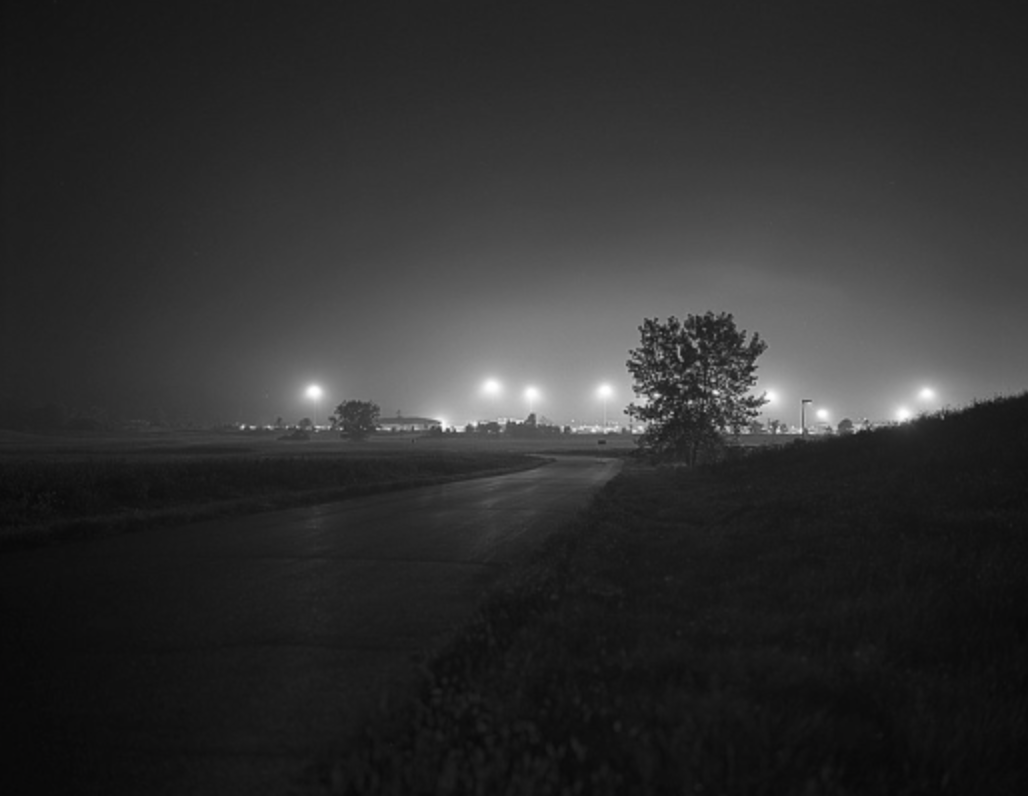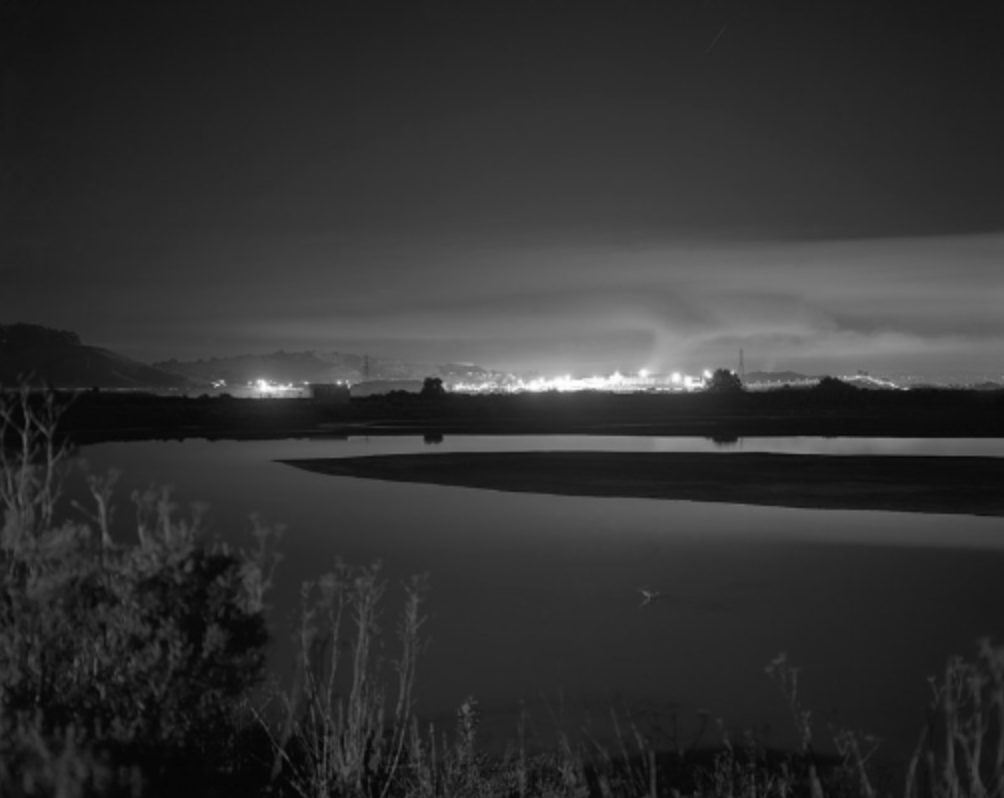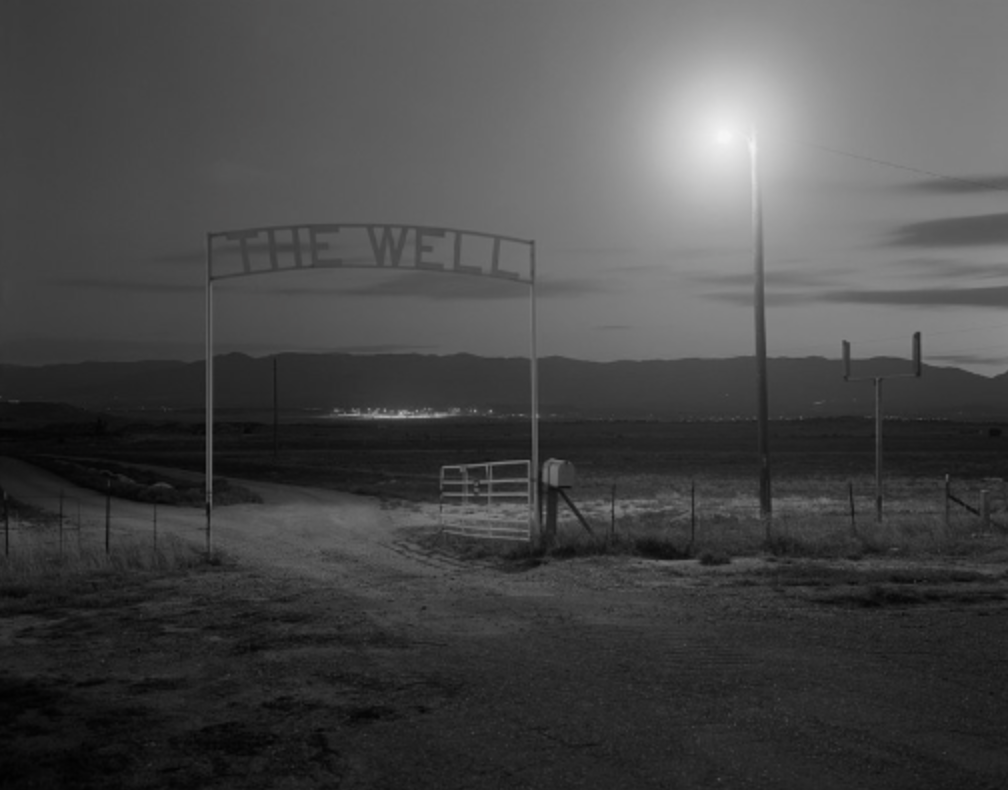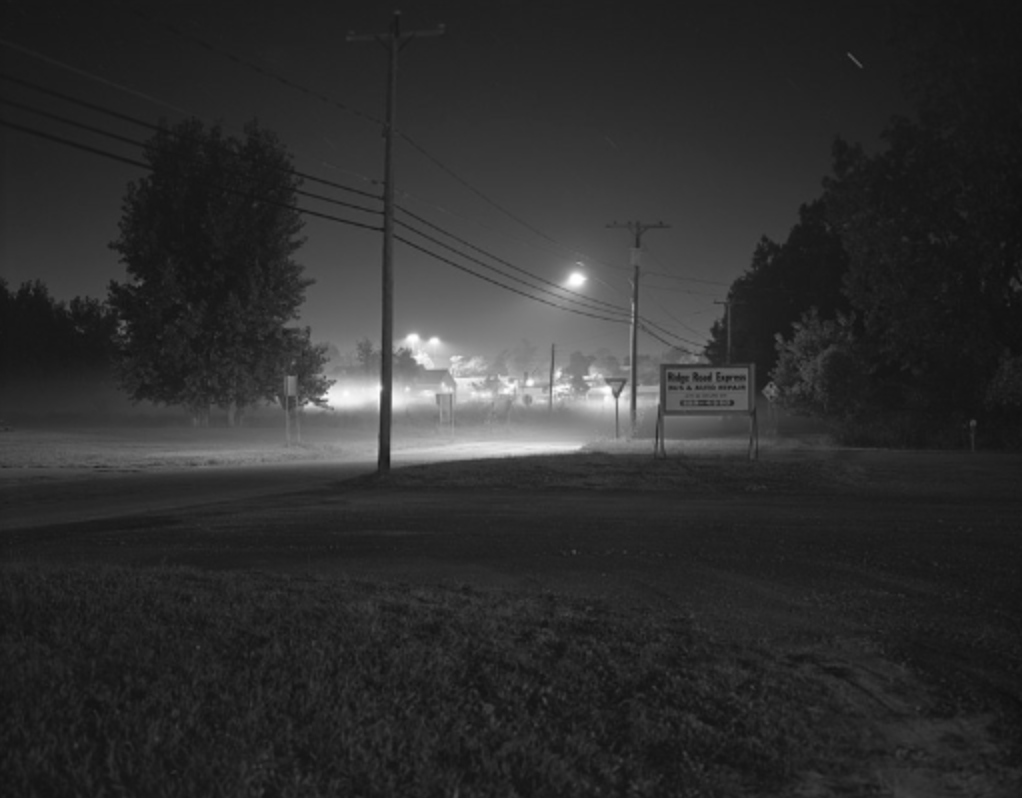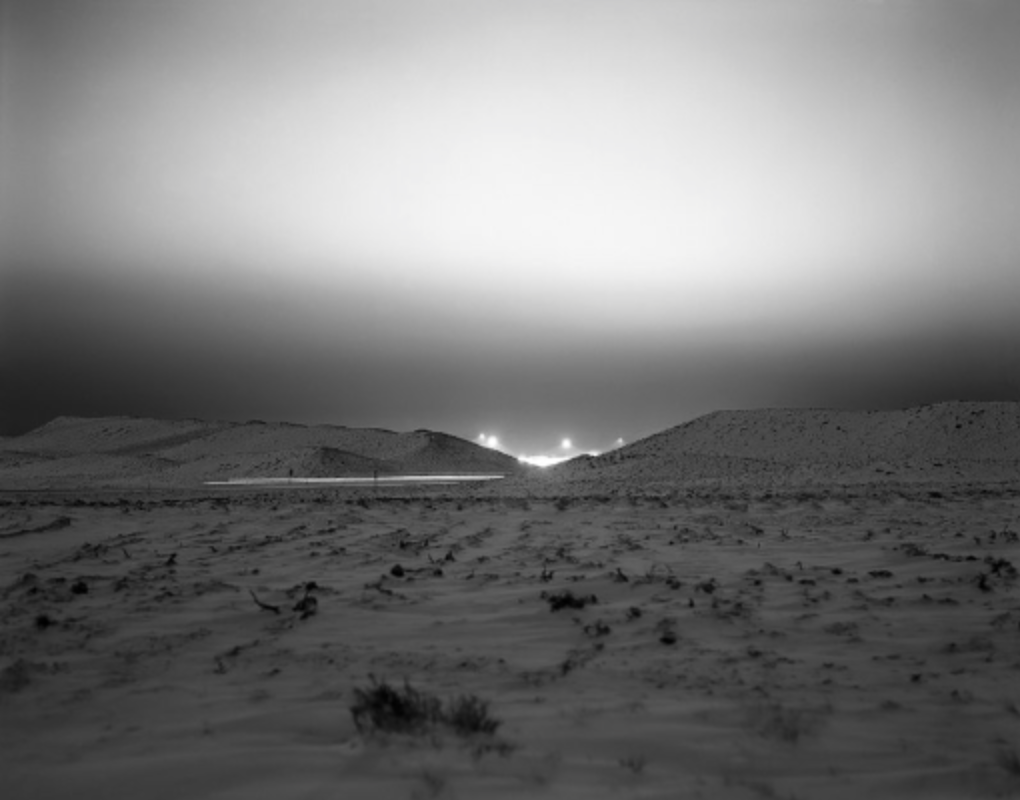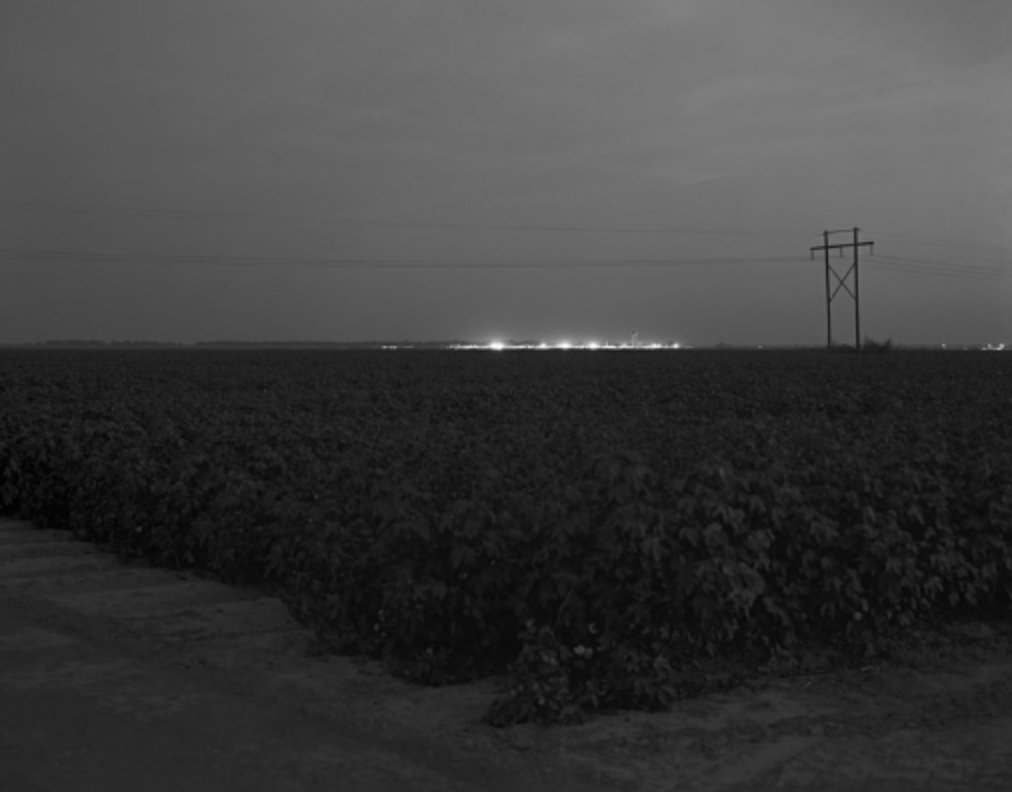Q&A: Steve Tourlentes
By Jess T. Dugan
Steve Tourlentes is a graduate of Knox College and Massachusetts College of Art, where he earned an MFA in 1988. Since 1996, Tourlentes has been photographing rural and suburban landscapes where penitentiaries are constructed, seen only by the bright light they emit at night. He is a recipient of grants from the John Simon Guggenheim Foundation, the Polaroid Corporation, and the Massachusetts Cultural Council.
Jess T. Dugan: What is your background in the arts, and how did you come to photography?
Steve Tourlentes: My parents were very involved in the arts while I was growing up. My father always took pictures and set up a small darkroom in our house when I was a teenager. I studied art while an undergraduate at Knox College in Galesburg, IL. After graduation I moved to Boston with some friends and played in a band for several years. Clearly the music career was not happening, so I enrolled in the MFA program at Massachusetts College of Art.
JTD: Let’s talk about your photographs of prisons. How did you begin to photograph prisons?
ST: The State of Illinois built a new medium security prison in my hometown in the late 1980’s to replace a large state mental hospital that my father had been superintendent of during the 1960’s. In a town that was in economic decline it was unusual to see these new bright lights illuminating the horizon that had once just been cornfields. There had been talk of building a prison before but the local community was always against it. When the hospital was closed and jobs were lost the prison plan became much more palpable based on people needing jobs. I made one image on a visit home that haunted me for several years. It’s not even a good image but there was an undercurrent that kept pulling me back in. It was through this image that I began to notice other new prisons sprouting up in rural areas and I began to research what was happening. At first, it was simply on a visual level but as I learned more about the prison system in this country I became obsessed.
JTD: Your images have received some attention recently, including the Massachusetts Cultural Council grant in 2007 and several exhibitions. What are your plans for this work, and are you working on anything specific right now?
ST: I have been very fortunate, without a Guggenheim Foundation grant and the Massachusetts Cultural Council grants much of this would not have happened. Ultimately, I would like to see this as a book; my efforts with this project are shifting in that direction.
JTD: What specifically is it about photographing prisons at night that you are attracted to?
ST: There is a separation that occurs when night falls and a prison becomes an optical presence in the landscape. In the darkness they make a defiant stance against the landscape surrounding it. They radiate light back into the landscape like an artificial sun. During the day the architecture and the perimeters are clearly demarcated; but in the darkness the visual boundaries extend beyond the walls. They become the light source that illuminates the visible landscape.
JTD: Do you research prisons before you go, and do you choose them for specific reasons? Once you are there, how long does it take you to scope out your location and set up your shot?
ST: Lot’s of traveling, and lot’s of research prior to each trip. The unfortunate circumstance of this project is the realization that there is a huge prison industry that has exploded in size over the last 25 years. I had some fantasy that I would have an image from every prison in the country but I there are too many to photograph all of them. Once I find a prison to photograph there is a lot of surveying the location to find the right angle. Technology has made it easier, and Google Earth is very helpful in scouting out the prison and it’s surroundings. I’m rather methodical and I’m not always welcomed by the authorities, it takes me forever and I always feel bad if someone has accompanied me and has to sit through my decision making process.
JTD: Looking at one of your photographs purely as an image, it is full of photographically appealing tones and lights. However, when you consider what is inside the perimeter of the lights, society has rejected, and is therefore, unappealing. Is this dichotomy between photographic beauty and the social reality something you intentionally employ, and if so, what kind of meaning do you hope it creates in your work?
ST: Beauty can subvert and hold our attention even if the subject is quite abject. Goya’s Disasters of War comes to mind as well as Warhol’s electric chair prints. For some these images might help them to consider something that they might normally find easy to ignore by the light of day. I hope the work helps to create a dialogue about why these places exist in such large numbers in the US.
JTD: The prison system in America is rapidly growing, primarily for economic reasons. Do you delve into the specific politics of prisons in America, or do you like to present the issue and let the viewer interpret it, as they will?
ST: The images make visible my critique of the growing prison industry. I see these mega institutions as examples of general failures in our society. That being said it is important to provide a basis for why this system is failing us. When I present the work, I provide background information to prevent there being too much ambiguity as to where I stand.
JTD: You generally photograph prisons from a distance- what is it about the prison as part of a larger landscape that interests you?
ST: Photographing the landscape has always been an interest of mine; with these images the prison itself becomes the connection to the different locations. The landscape is what changes while the architecture of the prisons functions essentially the same way it has for over 100 years. Searching out these sites has taken me to places in this country I never imagined I would travel to.
JTD: In some of your photographs, the prison closely borders a neighborhood or suburban area? What importance does this have for you, and what statement are you trying to make by showing this juxtaposition?
ST: The notion of physical and conceptual boundaries (as well as time) is inherent to prison culture. In some ways I look at this collection of images as metaphorical atlas of the U.S. It is the borders and the laws of particular states that determine the judicial response if incarceration is the verdict of the courts. I’ve found many strange juxtapositions of someone’s backyard looking directly onto a prison or new housing developments being built across the street from a maximum-security prison. In these circumstances it’s very clear the community that hosts these institutions have formed a complex symbiotic relationship.
JTD: Have you ever shown your work to officials within the prison system? If so, what has their reaction been?
ST: Yes, sometimes when I need permission I meet with prison officials or wardens. Most have been very positive about the images. Once I showed a warden in Louisiana a photo of a prison in California and he said I could photograph his prison if I made it look as good as the image of the California prison.
JTD: I have personally heard some funny stories from you about your strange encounters while photographing at night- could you tell us about your most interesting experience?
ST: There have been all sorts of interesting moments- I’ve been hassled by guards and the police, photographed in blizzards and lightening storms. Once, I was in Chula Vista, California on the US/Mexico border taking a picture without permission in the no-man’s land surrounding the state prison. Suddenly all hell broke loose, men on ATV’s with night vision and bright spotlights came out of nowhere… it was very X-Files. I thought they were after me but they shot right past me and about 100 yards away they stopped a group of people using the prison grounds to cross over the border from Mexico. They never even bothered with me… maybe they assumed with the big camera and tripod I was someone official.
JTD: Do you see yourself continuing this work indefinitely, or do you feel you will reach a point when the project is finished?
ST: I’m in the latter stages of the project now. There are a few more prisons that I need to photograph and then spend more time on my other projects. The scary thing for me is how immense the prison system has become, these pictures really only scratch the surface.
JTD: Do you think of your work as political?
ST: Absolutely, I feel the burgeoning prison system in this country reflects back on the society that builds them. You know we lock up more people than any other country in the world. I think the lack of funding for education, health care and an unwillingness to invest in our own citizens has resulted in a reactionary policy of prison building to help politicians get re-elected. Our thirst for punishment and prisons has created a profit based private prison industry that you can buy stock in. If you look at the demographics of the U.S. prison population it is predominately male, undereducated and poor. There are estimates that over 25% of those incarcerated are mentally ill prior to entering the system.
JTD: Have you ever been interested in going inside a prison to photograph, or of making portraits of prison inmates?
ST: There is large archive of photographers who have worked inside prisons all over this country. For me I felt I didn’t have anything new to add. Initially I did go inside to see if I wanted to make work of inmates or the interior architecture of the prison but the location and the world surrounding the prison felt more interesting to me visually. I guess I’m attempting to connect the outside world with these institutions. Looking from a distance at a place that is so highly serveilled becomes an investigation of the psychological as well as the physical boundaries. To me it becomes a form of visual feedback or echo.
Editor's note: this interview was originally published on July 13, 2008 on Big, Red, & Shiny.
All images © Steve Tourlentes
